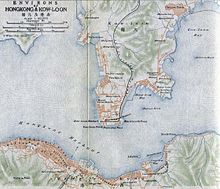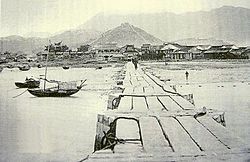Lung Tsun Stone Bridge



The Lung Tsun Stone Bridge (Chinese: 龍津石橋) was a bridge in British Hong Kong which was buried during the construction of Kai Tak Airport and which connected the Kowloon Walled City to a pier leading into Kowloon Bay.[1]
History
[edit]
In middle of the nineteenth century, European merchants used Chinese junks to smuggle goods and opium to the mainland. The Viceroy of Liangguang ordered a checkpoint to be set up in the water channel between Hong Kong and Macau. Due to the replenishment need for the customs ships, the stone bridge was proposed to be built and named after a nearby river, known as the Lung Tsun River.
Gambling was allowed in Hong Kong between 1867 and 1871 but was prohibited in 1872. The casinos moved to the Kowloon Walled City. As a nearby pier, in particular, the Lung Tsun Stone Bridge become a hotspot for many of the foreign gamblers arriving in Hong Kong.[2]
Construction on the bridge began in 1873 and was completed in 1875.[1] The bridge was about 210 metres (690 ft) long[3] and 2.6 metres (8.5 ft) wide and was built from granite. At the time, it was the longest and toughest stone pier in Hong Kong. It was divided into the south and the north.[4][clarification needed] Due to mud deposition surrounding the pier, its length was extended[when?] to 300 metres (980 ft) with wood. During the Japanese occupation of Hong Kong in WWII, the bridge was completely covered up when the nearby Kai Tak Airport was expanded.
Conservation
[edit]The bridge's remnants were first identified in April 2008.[5] Remnants of the bridge will be preserved in-situ as part of the redevelopment plan for the Kai Tak site.[1]
References
[edit]- ^ a b c The Standard, Relic will serve as bridge to Kai Tak's past, May 18, 2010 Archived October 16, 2012, at the Wayback Machine
- ^ 舊機場發現龍津石橋遺蹟《蘋果日報》2008年6月21日,香港
- ^ Civil Engineering and Development Department, Kowloon Development Office, "Agreement No. CE 35/2006(CE). Kai Tak Development Engineering Study. Further archaeological excavation report", August 2009
- ^ 吴偉鴻,九龍龍津橋考古發現
- ^ Antiquities and Monuments Office, "Remnants of Lung Tsun Stone Bridge in Kai Tak Area", Board Paper AAB/30/2009-10, December 2009 Archived 2012-04-04 at the Wayback Machine
Further reading
[edit]- Antiquities and Monuments Office, "Discovery of Longjin Bridge in Kai Tak Area", Board Paper AAB/60/2007-08, June 2008
- "Conservation Management Plan for the Site of Lung Tsun Stone Bridge" (PDF). Antiquities and Monuments Office. November 2009.
- Heritage Consultant AGC Design Ltd (August 2017). "Heritage Impact Assessment for Lung Tsun Stone Bridge Preservation Corridor at Kai Tak" (PDF). Antiquities Advisory Board. Architectural Services Department.


